Occupational environment monitoring at the seafood sauce products factory
99,000 ₫
Note: The above price is calculated for one sample, the price may vary depending on the area of the environment that needs monitoring and the movement of the market. For more accurate price support, please refer to the quotation table or contact directly with our consulting staff.
Environmental monitoring of a seafood sauce factory is a session of collecting, analyzing, and evaluating factors in the workplace that may harm workers health.
Table of Contents
Toggle1. Overview of the Seafood Sauce Products Factory
a. What is a seafood sauce products factory?
A seafood sauce products factory is a production facility designed specifically for manufacturing seafood sauces. This factory has specialized processes and equipment to process and ferment various types of seafood into seafood sauces.
Activities in a seafood sauce products factory include sourcing fresh or processed seafood from suppliers, cleaning the seafood, fermenting and aging it in containers or fermentation tanks, controlling the fermentation process, seasoning and salting, and finally packaging and canning the finished products.
During the production of seafood sauces, hygiene standards and production procedures must be strictly followed to ensure product quality and food safety. The factory also requires equipment and machinery such as fermentation systems, storage tanks, aging vats, wastewater treatment systems, and packaging machines.
A successful seafood sauce products factory requires expertise in seafood processing, fermentation processes, food hygiene and safety, and quality management.

b. Production stages in a seafood sauce products factory
The production stages in a seafood sauce products factory may include the following steps:
- Seafood sourcing: The factory purchases fresh or processed seafood from suppliers. This is an important step to ensure high-quality raw materials for seafood sauce production.
- Seafood cleaning: The seafood is cleaned to remove unnecessary parts such as intestines, scales, or hard parts of shrimp and crabs. This process ensures the purity and hygiene of the seafood.
- Fermentation: The cleaned seafood is placed in containers or fermentation vats with salt and sugar. This fermentation process is crucial, as bacteria capable of breaking down seafood produce organic acids, giving seafood sauces their characteristic flavor.
- Aging: After fermentation, the seafood is aged in containers or vats to allow fermentation to continue. Aging can last from several months to several years, depending on the type of sauce and specific production process.
- Process control: Throughout production, fermentation, seasoning, and salting are monitored and adjusted to ensure the quality and flavor of the seafood sauce.
- Packaging and canning: Once fermentation and aging are complete, the seafood sauce is packaged and canned. This final step preserves the product and makes it convenient for transportation and consumption.

c. Machinery used in seafood sauce production
Various types of machinery and equipment are used to support production in a seafood sauce factory. Some common machinery includes:
- Seafood grinders: Used to grind cleaned seafood into a fine texture, removing unnecessary parts such as bones, scales, or hard portions.
- Mixers: Used to mix the ground seafood with salt, sugar, and other spices in preparation for fermentation.
- Containers or fermentation vats: Used to age seafood with seasonings during fermentation. These containers or vats can be adjusted for temperature and environmental conditions to create optimal fermentation conditions.
- Temperature and humidity control systems: Used to maintain ideal conditions during fermentation to ensure consistent product quality.
- Packaging machines: Used to package and can finished seafood sauce products. These machines can be automatic or semi-automatic, increasing productivity and ensuring packaging quality.
- Washing and cleaning machines: Used to clean equipment and surfaces that come into contact with seafood, ensuring hygiene and food safety.
- Wastewater treatment systems: Equipment used to treat and discharge wastewater from production, complying with environmental regulations.
- Automated management systems: Used to monitor and control production processes, temperature, humidity, and other parameters to ensure accurate and efficient production.

d. Occupational diseases for workers in seafood sauce factories
Workers in seafood sauce factories may be exposed to the following occupational diseases:
- Respiratory diseases: Workers may be affected by foul-smelling gases from fermentation and seafood decomposition. Long-term exposure can cause rhinitis, bronchitis, or other respiratory issues.
- Skin diseases: Continuous contact with seafood and chemicals during production can lead to skin irritation, dermatitis, or allergic reactions. Chemicals and salt may cause dry, cracked skin.
- Digestive system disorders: Working in seafood sauce environments can expose workers to harmful substances. Ingesting these substances or contact with high salt levels may affect the digestive system, causing stomach, intestinal, and other digestive problems.
- Nervous system disorders: Certain chemicals used during production may affect the nervous system. Long-term exposure can cause dizziness, headaches, sleep disorders, and other neurological issues.
- Musculoskeletal disorders: Work in seafood sauce factories may require physical exertion in awkward positions, causing stress on muscles and bones, which can lead to back pain, neck pain, and other musculoskeletal problems.

e. Popular types of seafood sauces in the market
There are many popular types of seafood sauces on the market, including:
- Fish sauce: Made from fresh fish such as anchovies, herring, mackerel, or cobia. Fish sauce has a rich flavor and is widely used in many dishes.
- Shrimp sauce: Made from fresh shrimp, typically giant freshwater or tiger shrimp. Shrimp sauce has a distinct aroma and is essential in many traditional dishes.
- Squid sauce: Made from fresh squid, usually tube squid or stuffed squid. Squid sauce has a unique aroma and adds strong flavor to dishes.
- Crab sauce: Made from fresh crabs, usually freshwater or marine crabs. Crab sauce has a beautiful golden color and a characteristic flavor.
- Clam sauce: Made from fresh clams, usually scallops or Japanese scallops. Clam sauce has a distinctive flavor and is used in seafood dishes.
- Razor clam sauce: Made from fresh razor clams. It has a light pink color and a distinctive taste for rich-flavored dishes.
- Snail sauce: Made from fresh snails, such as horned snails or apple snails. Snail sauce has a strong flavor and is used in many dishes.
2. Overview of occupational environment monitoring services
a. What is occupational environment monitoring at seafood sauce factories?
Occupational environment monitoring (or workplace environment measurement) at seafood sauce factories involves collecting, evaluating, and analyzing measured indicators of workplace environmental factors to implement timely measures, reduce environmental health risks for workers, and prevent occupational diseases. Occupational environment monitoring is mandatory for seafood sauce factories.
Monitoring is critical for protecting and promoting workers’ health, as employees are the primary resource and directly contribute to the enterprise’s profit. Workers who are frequently exposed to hazardous factors exceeding permissible limits may experience health problems and develop occupational diseases.
REGISTER FOR OCCUPATIONAL ENVIRONMENT MONITORING SERVICE
b. Nam Viet’s occupational environment monitoring program
Nam Viet’s occupational environment monitoring program is developed by engineers specialized in occupational safety and environmental protection. Aiming to ensure workers’ health and safety, the program uses modern measurement methods to monitor air quality, water, microclimate factors, physical factors, dust, and more in the workplace. This program plays a vital role in ensuring a safe working environment and protecting workers’ health.
Additionally, Nam Viet’s program contributes to researching and developing new solutions to improve workplace environmental quality. With a dedicated and professional team of monitoring specialists, Nam Viet’s exclusive monitoring program represents a breakthrough in occupational safety management and environmental protection in Vietnam.

c. Standardization in workplace measurement procedures
Standardization in Nam Viet’s occupational environment measurement procedures is crucial for ensuring accurate and reliable results. The program follows recognized standards and procedures from the Ho Chi Minh City Department of Health. This ensures collected data can be reliably used in evaluating workplace conditions and making decisions to improve the working environment and protect employees’ health.
These standardized procedures also ensure that measurements are conducted by highly qualified monitoring specialists with years of experience, enabling managers and experts to trust Nam Viet’s results and make accurate decisions to safeguard health and the environment.
By applying standardization in workplace measurement procedures, Nam Viet demonstrates its commitment to providing a safe working environment and protecting employees’ health, while actively contributing to the development and improvement of occupational safety and environmental management in Vietnam.
d. Reporting results of occupational environment monitoring at seafood sauce factories
Monitoring results are prepared according to Form No. 04, Appendix III issued with Decree 44/2016/ND-CP and prepared in two copies: one sent to the contracted enterprise and one retained by the monitoring organization.
The storage period for monitoring results is unlimited, according to legal regulations.

e. Frequency of occupational environment monitoring according to the law
According to Clause 2, Article 18 of the Law on Occupational Safety and Hygiene 84/2015/QH13, employers must organize occupational environment monitoring to evaluate harmful factors at least once a year.
f. Deadline for submitting occupational environment monitoring reports according to the law
The deadline for submitting reports is before December 31 each year. Enterprises in production facilities must submit their occupational environment monitoring reports to the Department of Health in the locality where the business headquarters and employees are located.
When there are changes in technology, production processes, or renovations that may introduce new hazards, enterprises must update occupational hygiene records regarding harmful factors that require monitoring.
g. Regulations on penalties for violations of occupational environment monitoring by employers
According to Article 27 of Decree No. 12/2022/ND-CP dated January 17, 2022, on administrative penalties in labor, social insurance, and Vietnamese employees working abroad under contracts:
- Clause 2: A fine of 2,000,000 – 5,000,000 VND for employers who fail to publicly disclose monitoring results to employees at the monitored site and the workplace immediately after results are available.
- Clause 3: A fine of 20,000,000 – 40,000,000 VND for employers who fail to conduct occupational environment monitoring to control health risks as required by law.
- Clause 4: A fine of 40,000,000 – 60,000,000 VND for employers who collude with monitoring organizations to falsify monitoring activities but have not reached criminal liability.
3. Harmful environmental factors for workers in seafood sauce production factories
Workers in seafood sauce production factories may be exposed to the following harmful environmental factors:
- Fumes and chemicals: The fermentation and processing of seafood sauce produce pungent fumes containing chemicals such as amino acids and organic acids. Prolonged exposure to these fumes and chemicals can cause respiratory and eye irritation, discomfort, and negatively affect health.
- Dust and unpleasant odors: Processing and grinding seafood to produce sauce can generate dust and unpleasant smells. Long-term exposure to this dust and odor may lead to respiratory irritation, headaches, and discomfort for workers.
- Noise: Machinery and equipment used in seafood sauce production can generate high noise levels. Prolonged exposure can damage hearing and cause health issues such as stress, insomnia, and fatigue.
- Humidity and temperature: The work environment in seafood sauce factories is often high in humidity and temperature, which can cause discomfort, fatigue, and impact workers’ health.
- Toxic materials: Certain toxic materials, such as bleaching agents, preservatives, or additives, may be used during production. Exposure to these materials can be harmful to workers if not properly managed and used.
REGISTER FOR OCCUPATIONAL ENVIRONMENT MONITORING SERVICE
4. Measures to improve the working environment in seafood sauce production factories
To improve the working environment in seafood sauce production factories and protect workers’ health, the following measures can be applied:
- Ventilation and exhaust systems: Ensure the factory has effective ventilation and exhaust systems to remove fumes, chemicals, and unpleasant odors from the workplace. This helps minimize exposure to irritants and reduces unpleasant smells.
- Use of protective equipment: Workers should be provided with and properly use personal protective equipment such as masks, safety goggles, helmets, and gloves to protect against fumes, dust, and chemicals.
- Training and education: Workers should receive training on safety and hygiene measures, including the proper use of protective equipment, waste handling, and emergency response procedures. Education on safety awareness and health is also important to increase awareness of workplace environmental impacts and personal protection.
- Regular equipment inspection and maintenance: Ensure machinery and equipment are periodically inspected, maintained, and properly cleaned. This reduces the risk of accidents and ensures safety during production.
- Waste management: Properly handle waste from seafood sauce production in compliance with environmental regulations. Ensure waste is treated safely to avoid negative impacts on the environment and human health.
- Adjusting the work environment: Create comfortable working conditions with appropriate humidity and temperature. This helps ensure worker comfort and reduces fatigue and health risks.
- Periodically conduct occupational environment monitoring in factories, collecting and analyzing harmful factors to adjust and reduce risks, preventing occupational diseases.
5. Benefits of periodic monitoring in seafood sauce production factories
An Toan Nam Viet provides enterprises with excellent benefits when using occupational environment monitoring services according to Decree 44/2016/NĐ – CP on managing and controlling harmful factors in the workplace affecting employees.
- Enterprises can proactively control harmful factors in workshops or factories.
- Receive recommendations on measures to reduce harmful factors and improve workplace quality.
- Indirectly protect human resources, a key factor in enterprise development.
- Reduce the impact of occupational diseases on health, thereby minimizing future treatment costs.
- Improved worker health enhances product quality and ensures stable production output.
- Ensure compliance with labor safety laws and avoid legal risks.
- Enhance credibility and professionalism in all aspects, elevating the enterprise’s brand.
Nam Viet’s environmental monitoring service is a solution to reduce occupational disease risks, contributing to a healthy and high-quality working environment.

6. National occupational environment monitoring center
Nam Viet Occupational Environment Monitoring Center is a professional unit specializing in monitoring and measuring occupational environment quality across all provinces in Vietnam. With an experienced team of monitoring specialists, the center uses modern measurement equipment, ensuring accuracy and reliability.
In addition to monitoring services, the center assists clients in planning, managing, and tracking occupational environment issues. With the motto “customers are central,” the center prioritizes client satisfaction, meets all needs, and is committed to providing the best solutions for enterprises.
REGISTER FOR OCCUPATIONAL ENVIRONMENT MONITORING SERVICE
With investments in technology, equipment, and human resources, Nam Viet’s monitoring center has become one of the most reputable units in occupational environment monitoring in Ho Chi Minh City, with the following goals:
- We always value our brand reputation and the quality of our services.
- We provide clients with the best and most suitable solutions possible.
- Along with a team of experienced Masters and Engineers, we aim to protect the environment and benefit enterprises.
- Working with Nam Viet Monitoring Team, companies will receive professional service from experts and enjoy the best cost advantages.
The occupational environment monitoring process at Nam Viet includes the following steps:
- Before monitoring, ensure all machinery and equipment are calibrated and adjusted according to legal regulations.
- Strictly follow the occupational environment monitoring procedures as committed to the Department of Health.
- Accurately report monitoring results to employers.
- If monitoring results indicate unsafe conditions for workers, Nam Viet will provide remedial measures, and the workplace will:
- Implement measures to improve working conditions to minimize harmful impacts and prevent occupational diseases.
- Organize health checks to detect occupational and work-related illnesses early for workers in unsafe environments.
- Provide allowances in kind for workers according to labor law regulations.

7. Occupational environment monitoring service quotation
To help enterprises perform occupational environment monitoring professionally and effectively, Nam Viet provides customers with a detailed quotation for occupational environment monitoring services with quality and reasonable cost.
- Our quotation provides detailed pricing for the monitoring services we offer, including costs for transportation, measurement, analysis, and reporting. Customers can rely on the accuracy and reliability of the reports we provide.
- We are committed to offering competitive and reasonable prices, and we are ready to provide prompt and professional consultation for any questions regarding monitoring services.
- With Nam Viet’s quotation, customers can easily select service packages that suit their needs. We are committed to delivering the highest satisfaction with professional service quality.
No comments yet

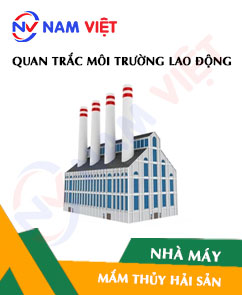
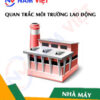
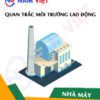
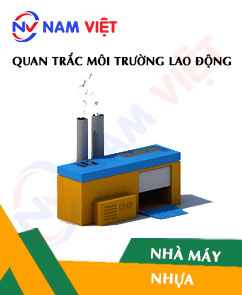



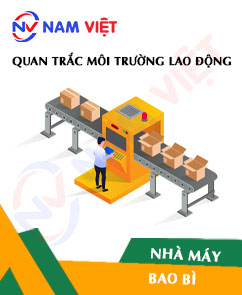


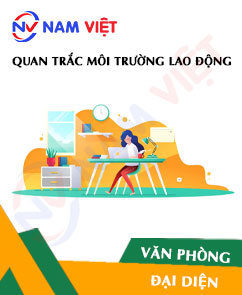
Review Occupational environment monitoring at the seafood sauce products factory
There are no reviews yet.